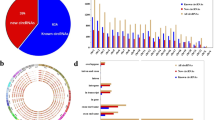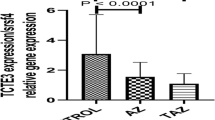Abstract
Background
Numerous pieces of evidence show that many environmental and genetic factors can cause male infertility. Much research in recent years has investigated the function of long non-coding RNAs (lncRNAs) in fertility. The main objective of the current study was to investigate the expression of Dynein Axonemal Heavy Chain 5 (DNAH5) as a gene that plays an essential role in sperm motility in individuals with asthenozoospermia and terato-asthenozoospermia. Alterations in linc02220 expression (located close to the DNAH5 gene), its action potential in DNAH5 regulating, and the correlation between their expression and normal sperm morphology and motility were also examined.
Method and material:
This study examined the semen of 31 asthenozoospermia individuals (AZ), 33 terato-asthenozoospermia (TAZ) individuals, and 33 normospermia (NZ) individuals with normal sperm as a control group. The expression levels of DNAH5 and linc02220 in the sperm samples were analyzed by real-time PCR.
Results
Gene expression analysis revealed a significant association between DNAH5 expression and sperm motility and morphology (p < 0.0001). The DNAH5 expression levels in the TAZ and AZ groups were also significantly reduced; however, linc02220 was significantly upregulated in both TAZ and AZ groups compared to the NZ group (p < 0.0001). DNAH5 expression in the TAZ and AZ groups was negatively correlated with linc02220 expression, thus, DNAH5 downregulation was associated with linc02220 overexpression (p < 0.05).
Conclusions
The gene linc02220 could be a potential regulatory target for DNAH5, and both could affect sperm’s normal motility and morphology.


Similar content being viewed by others
Data Availability
The datasets analyzed during the current study are available from the corresponding author by his decision on reasonable request.
References
Heidary Z, Zaki-Dizaji M, Saliminejad K, Khorram Khorshid HR (2019) MicroRNA profiling in spermatozoa of men with unexplained asthenozoospermia. Andrologia 51(6):e13284
Moraes APP, Barreto SM, Passos VMA, Golino PS, Costa JA, Vasconcelos MX (2011) Incidence and main causes of severe maternal morbidity in São Luís, Maranhão, Brazil: a longitudinal study. Sao Paulo Med J 129:146–152
Lehti MS, Sironen A (2017) Formation and function of sperm tail structures in association with sperm motility defects. Biol Reprod 97(4):522–536
Cao X, Cui Y, Zhang X, Lou J, Zhou J, Bei H et al (2018) Proteomic profile of human spermatozoa in healthy and asthenozoospermic individuals. Reproductive Biology and Endocrinology 16(1):1–8
Piomboni P, Focarelli R, Stendardi A, Ferramosca A, Zara V (2012) The role of mitochondria in energy production for human sperm motility. Int J Androl 35(2):109–124
Bonanno O, Romeo G, Asero P, Pezzino FM, Castiglione R, Burrello N et al (2016) Sperm of patients with severe asthenozoospermia show biochemical, molecular and genomic alterations. Reproduction 152(6):695–704
Rotondo JC, Lanzillotti C, Mazziotta C, Tognon M, Martini F (2021) Epigenetics of male infertility: The role of DNA methylation.Frontiers in Cell and Developmental Biology. :1822
Arcaniolo D, Favilla V, Tiscione D, Pisano F, Bozzini G, Creta M et al (2014) Is there a place for nutritional supplements in the treatment of idiopathic male infertility? Archivio Italiano di Urologia e Andrologia 86(3):164–170
Bracke A, Peeters K, Punjabi U, Hoogewijs D, Dewilde S (2018) A search for molecular mechanisms underlying male idiopathic infertility. Reprod Biomed Online 36(3):327–339
Fliegauf M, Benzing T, Omran H (2007) When cilia go bad: cilia defects and ciliopathies. Nat Rev Mol Cell Biol 8(11):880–893
Satir P, Mitchell DR, Jékely G (2008) How did the cilium evolve? Curr Top Dev Biol 85:63–82
Loges NT, Antony D, Maver A, Deardorff MA, Güleç EY, Gezdirici A et al (2018) Recessive DNAH9 loss-of-function mutations cause laterality defects and subtle respiratory ciliary-beating defects. Am J Hum Genet 103(6):995–1008
Zuccarello D, Ferlin A, Cazzadore C, Pepe A, Garolla A, Moretti A et al (2008) Mutations in dynein genes in patients affected by isolated non-syndromic asthenozoospermia. Hum Reprod 23(8):1957–1962
Dong FN, Amiri-Yekta A, Martinez G, Saut A, Tek J, Stouvenel L et al (2018) Absence of CFAP69 causes male infertility due to multiple morphological abnormalities of the flagella in human and mouse. Am J Hum Genet 102(4):636–648
Coutton C, Vargas AS, Amiri-Yekta A, Kherraf Z-E, Ben Mustapha SF, Le Tanno P et al (2018) Mutations in CFAP43 and CFAP44 cause male infertility and flagellum defects in Trypanosoma and human. Nat Commun 9(1):1–18
Ebrahimi N, Parkhideh S, Samizade S, Esfahani AN, Samsami S, Yazdani E et al (2022) Crosstalk between lncRNAs in the apoptotic pathway and therapeutic targets in cancer.Cytokine & Growth Factor Reviews. 2022/04/20/.
Lanzillotti C, De Mattei M, Mazziotta C, Taraballi F, Rotondo JC, Tognon M et al Long Non-coding RNAs and MicroRNAs Interplay in Osteogenic Differentiation of Mesenchymal Stem Cells.Frontiers in Cell and Developmental Biology. 2021 2021-April-09;9. English.
Bond AM, VanGompel MJ, Sametsky EA, Clark MF, Savage JC, Disterhoft JF et al (2009) Balanced gene regulation by an embryonic brain ncRNA is critical for adult hippocampal GABA circuitry. Nat Neurosci 12(8):1020–1027
Sauvageau M, Goff LA, Lodato S, Bonev B, Groff AF, Gerhardinger C et al (2013) Multiple knockout mouse models reveal lincRNAs are required for life and brain development. elife 2:e01749
Marques CJ, Carvalho F, Sousa M, Barros A (2004) Genomic imprinting in disruptive spermatogenesis. Lancet (London, England). May 22;363(9422):1700-2. PubMed PMID: 15158633. Epub 2004/05/26. eng
Aliakbari F, Eshghifar N, Mirfakhraie R, Pourghorban P, Azizi F (2021 Jul) Coding and Non-Coding RNAs, as Male Fertility and Infertility Biomarkers. Int J fertility Steril 15(3):158–166 PubMed PMID: 34155862. Pubmed Central PMCID: PMC8233923. Epub 2021/06/23. eng
Luk AC-S, Gao H, Xiao S, Liao J, Wang D, Tu J et al (2015) GermlncRNA: a unique catalogue of long non-coding RNAs and associated regulations in male germ cell development. Database. ;2015
Necsulea A, Soumillon M, Warnefors M, Liechti A, Daish T, Zeller U et al (2014) The evolution of lncRNA repertoires and expression patterns in tetrapods. Nature 505(7485):635–640
Joshi M, Rajender S (2020) Long non-coding RNAs (lncRNAs) in spermatogenesis and male infertility. Reproductive Biology and Endocrinology 18(1):1–18
Association WM (2018) WMA Declaration of Helsinki–Ethical Principles for Medical Research Involving Human Subjects. July 9, 2019
Lu J-C, Huang Y-F, Lü N-Q (2010) WHO Laboratory Manual for the Examination and Processing of Human Semen: its applicability to andrology laboratories in China. Zhonghua nan ke xue = National journal of andrology 16(10):867–871
Pfaffl MW (2004) Quantification strategies in real-time PCR. AZ of quantitative PCR 1:89–113
McKight PE, Najab J (2010) Kruskal-wallis test. The corsini encyclopedia of psychology. :1-
Sironen A, Shoemark A, Patel M, Loebinger MR, Mitchison HM (2020) Sperm defects in primary ciliary dyskinesia and related causes of male infertility. Cell Mol Life Sci 77(11):2029–2048
Tang S, Wang X, Li W, Yang X, Li Z, Liu W et al (2017) Biallelic mutations in CFAP43 and CFAP44 cause male infertility with multiple morphological abnormalities of the sperm flagella. Am J Hum Genet 100(6):854–864
Raidt J, Loges NT, Kaiser T, Wallmeier J, Pennekamp P, Omran H Motility of efferent duct cilia aids passage of sperm cells through the male reproductive system
Hornef N, Olbrich H, Horvath J, Zariwala MA, Fliegauf M, Loges NT et al (2006) DNAH5 mutations are a common cause of primary ciliary dyskinesia with outer dynein arm defects. Am J Respir Crit Care Med 174(2):120–126
Heidary Z, Saliminejad K, Zaki-Dizaji M, Khorram Khorshid HR (2020) Genetic aspects of idiopathic asthenozoospermia as a cause of male infertility. Hum Fertility 23(2):83–92
Gravesande KSvs, Omran H (2005) Primary ciliary dyskinesia: clinical presentation, diagnosis and genetics. Ann Med 37(6):439–449
Pereira R, Oliveira J, Ferraz L, Barros A, Santos R, Sousa M (2015) Mutation analysis in patients with total sperm immotility. J Assist Reprod Genet 32(6):893–902 PubMed PMID: 25877373. Epub 04/16. eng
Wang K, Chen X, Guo C, Liu F, Wang J, Sun L (2018) Cilia ultrastructural and gene variation of primary ciliary dyskinesia: report of three cases and literatures review. Zhonghua er ke za zhi = Chinese. J Pediatr 56(2):134–137
Luk A, Chan W-Y, Rennert OM, Lee T-L (2014) Long noncoding RNAs in spermatogenesis: insights from recent high-throughput transcriptome studies. Reproduction 147(5):R131–R41
Zhao S, Heng N, Weldegebriall Sahlu B, Wang H, Zhu H (2021) Long noncoding RNAs: Recent insights into their role in male infertility and their potential as biomarkers and therapeutic targets. Int J Mol Sci 22(24):13579
Saberiyan M, Mirfakhraie R, Moghni M, Teimori H Study of Linc00574 Regulatory Effect on the TCTE3 Expression in Sperm Motility.Reproductive Sciences. 2021 2021/01/01; 28(1):159–65
Kamel A, Saberiyan M, Mirfakhraie R, Teimori H Reduced expression of CFAP44 and CFAP44-AS1 may affect sperm motility and morphology. Andrologia.n/a(n/a):e14447
Omran H, Haffner K, Volkel A, Kuehr J, Ketelsen U-P, Ross U-H et al (2000) Homozygosity mapping of a gene locus for primary ciliary dyskinesia on chromosome 5p and identification of the heavy dynein chain DNAH5 as a candidate gene. Am J Respir Cell Mol Biol 23(5):696–702
Cunningham F, Allen JE, Allen J, Alvarez-Jarreta J, Amode MR, Armean Irina M et al (2022) Ensembl 2022. Nucleic Acids Res 50(D1):D988–D95
Paraskevopoulou MD, Hatzigeorgiou AG (2016) Analyzing miRNA–lncRNA interactions. Springer, Long non-coding RNAs, pp 271–286
Acknowledgements
We gratefully thank the Research and Technology Deputy of Shahrekord University of Medical Sciences for their support.
Funding
This research was supported by the Shahrekord University of Medical Sciences (Grant no. 3181).
Author information
Authors and Affiliations
Contributions
AK and MS designed the study, carried out data collection and manuscript drafting. SA contributed to data analysis and manuscript drafting. HT supervised the study and manuscript editing. All authors approved the final version for publication.
Corresponding author
Ethics declarations
Ethical approval and Consent to participate
The study was approved by Research Ethics Committee of Shahrekord University of Medical Sciences (ethics code: IR.SKUMS.REC.1398.155). All the patients signed written informed consent to participate in the study. The Declaration of Helsinki was considered in this study.
Conflict of interest
The authors declare that they have no known conflict of interests or personal relationships that could have appeared to influence the work reported in this paper.
Additional information
Publisher’s Note
Springer Nature remains neutral with regard to jurisdictional claims in published maps and institutional affiliations.
Rights and permissions
Springer Nature or its licensor holds exclusive rights to this article under a publishing agreement with the author(s) or other rightsholder(s); author self-archiving of the accepted manuscript version of this article is solely governed by the terms of such publishing agreement and applicable law.
About this article
Cite this article
Kamel, A., Saberiyan, M., Adelian, S. et al. DNAH5 gene and its correlation with linc02220 expression and sperm characteristics. Mol Biol Rep 49, 9365–9372 (2022). https://doi.org/10.1007/s11033-022-07787-2
Received:
Accepted:
Published:
Issue Date:
DOI: https://doi.org/10.1007/s11033-022-07787-2




